Page path:
- Modern Dinocyst Key
- brown cysts
- cysts with peridinioid form
- Peridinioid cysts with spines-processes
- Xandarodinium xanthum
Xandarodinium xanthum
Zonneveld, K.A.F. and Pospelova V. (2015). A determination key for modern dinoflagellate cysts. Palynology 39 (3), 387- 407.
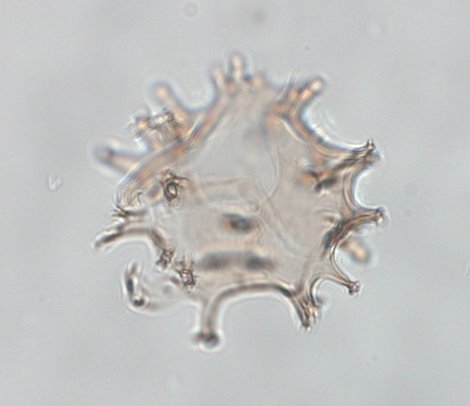
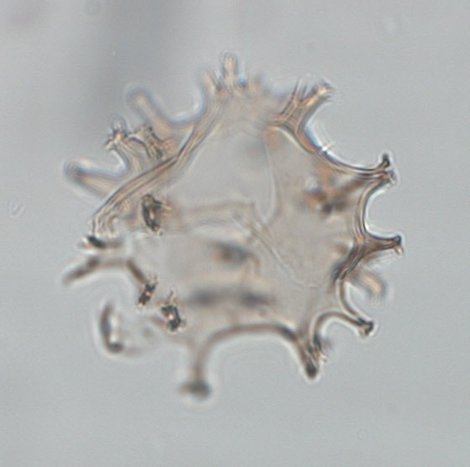
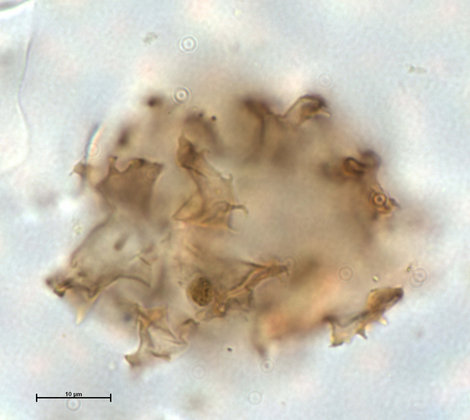
cross section view
photo: Karin Zonneveld
photo: Karin Zonneveld
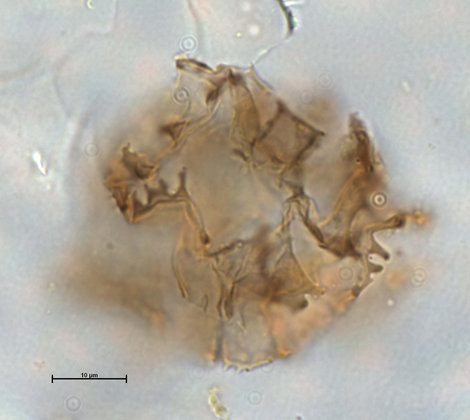
lateral view
detail processes
photo: Karin Zonneveld
detail processes
photo: Karin Zonneveld
dorsal view
Photo: Karin Zonneveld
Photo: Karin Zonneveld
lateral view
detail processes
photo: Karin Zonneveld
detail processes
photo: Karin Zonneveld
Field Characteristics
Xandarodinium xanthum Reid 1977
Field characteristics:
A species of Xandarodinium with a concave ventral area and convex dorsal area. Wall thin with a smooth surface. Processes have elliptical circular or elongate bases in plan view; form as extensions from the wall, and are terminated by simple spines or multifurcate extensions. Ventral surface and anterior dorsal surface, smooth and not ornamented by processes.
Motile affinity: Protoperidinium divaricatum (Meunier 1919) Parke et Dodge 1976.
Cyst theca relationship: Matsuoka et al., 1983
Comparison with other species:
This species can be hard to distinguish as being frequently covered by some sort of amorphic organic matter or “dirt”. It is often folded and it is sometimes difficult to recognise a dinoflagellate cyst in it. The tips of the spines on the processes are often a little thicker and dark brown in colour.
Field characteristics:
A species of Xandarodinium with a concave ventral area and convex dorsal area. Wall thin with a smooth surface. Processes have elliptical circular or elongate bases in plan view; form as extensions from the wall, and are terminated by simple spines or multifurcate extensions. Ventral surface and anterior dorsal surface, smooth and not ornamented by processes.
Motile affinity: Protoperidinium divaricatum (Meunier 1919) Parke et Dodge 1976.
Cyst theca relationship: Matsuoka et al., 1983
Comparison with other species:
This species can be hard to distinguish as being frequently covered by some sort of amorphic organic matter or “dirt”. It is often folded and it is sometimes difficult to recognise a dinoflagellate cyst in it. The tips of the spines on the processes are often a little thicker and dark brown in colour.
Geographic Distribution
Geographic distribution based on :
Zonneveld et al., 2013. Atlas of modern dinoflagellate cyst distribution based on 2405 datapoints. Review of Palaeobotany and Palynology, v. 191, 1-197
Zonneveld et al., 2013. Atlas of modern dinoflagellate cyst distribution based on 2405 datapoints. Review of Palaeobotany and Palynology, v. 191, 1-197
The distribution of Xandarodinium xanthum is mainly restricted to coastal temperate to tropical regions on the Northern Hemisphere. Its distribution is not restricted to full marine environments but it also occurs in hypo and hypersaline settings. It is registered in oligotrophic to eutrophic environments where bottom waters are well ventilated.
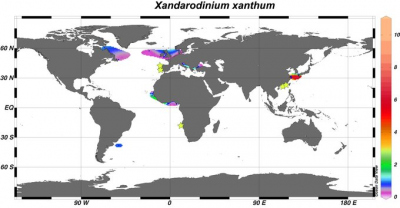
Distribution:
Xandarodinium xanthum is restricted to coastal sediments from temperate to tropical regions on the Northern Hemisphere with the exception of two observations in the South Atlantic Ocean. Highest abundances (up to 10%) occur in the East China Sea and the upwelling areas off equatorial west Africa.
Environmental parameter range:
SST: 4.1 - 28.7°C (winter - winter) with exception of one site where temperatures drop to -1°C (winter) and -1.3°C (spring) [P]: 0.06 - 0.67 μmol/l, [N]: 0.6 - 8.40 μmol/l, chlorophyll-a: 0.01 - 9.6 ml/l, bottom water [O2]: 1.6 - 6.3 ml/l.
Xandarodinium xanthum is abundant in regions where SSS may be reduced to 21.9 - 22.2 throughout the year (e.g. Black Sea and Marmara Sea), or never drop below 37. It occurs in oligotrophic as well as eutrophic environments. These include upwelling areas where upper water conditions can vary largely throughout the year. It is not observed in regions where mean annual [N]: < 0.56 μmol/l.
Comparison with other records:
Apart from the recordings in this Atlas Xandarodinium xanthum has been observed in coastal sediments off China (Wang et al., 2004c), sediments off India (D'Costa et al., 2008), the upwelling area off the Iberian Peninsula (Sprangers et al., 2004; Ribeiro and Amorim, 2008) and the Angola-Benguela Front region (Dale et al., 2002). No clear seasonal production pattern has been observed in the upwelling region off Iberia (Ribeiro and Amorim, 2008).
Xandarodinium xanthum is restricted to coastal sediments from temperate to tropical regions on the Northern Hemisphere with the exception of two observations in the South Atlantic Ocean. Highest abundances (up to 10%) occur in the East China Sea and the upwelling areas off equatorial west Africa.
Environmental parameter range:
SST: 4.1 - 28.7°C (winter - winter) with exception of one site where temperatures drop to -1°C (winter) and -1.3°C (spring) [P]: 0.06 - 0.67 μmol/l, [N]: 0.6 - 8.40 μmol/l, chlorophyll-a: 0.01 - 9.6 ml/l, bottom water [O2]: 1.6 - 6.3 ml/l.
Xandarodinium xanthum is abundant in regions where SSS may be reduced to 21.9 - 22.2 throughout the year (e.g. Black Sea and Marmara Sea), or never drop below 37. It occurs in oligotrophic as well as eutrophic environments. These include upwelling areas where upper water conditions can vary largely throughout the year. It is not observed in regions where mean annual [N]: < 0.56 μmol/l.
Comparison with other records:
Apart from the recordings in this Atlas Xandarodinium xanthum has been observed in coastal sediments off China (Wang et al., 2004c), sediments off India (D'Costa et al., 2008), the upwelling area off the Iberian Peninsula (Sprangers et al., 2004; Ribeiro and Amorim, 2008) and the Angola-Benguela Front region (Dale et al., 2002). No clear seasonal production pattern has been observed in the upwelling region off Iberia (Ribeiro and Amorim, 2008).


